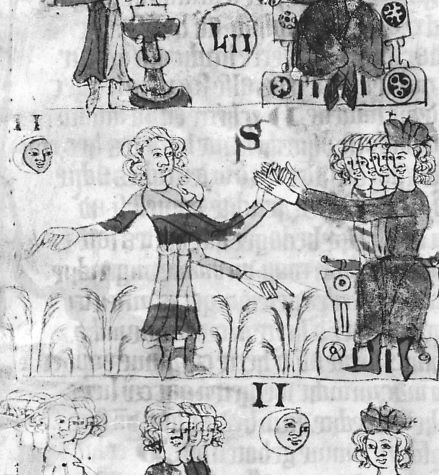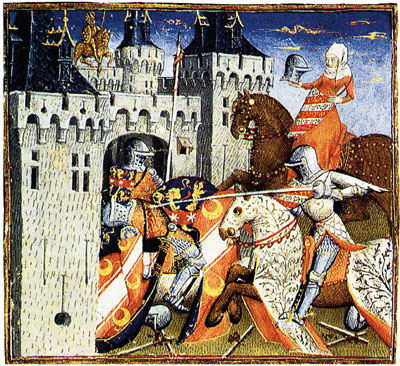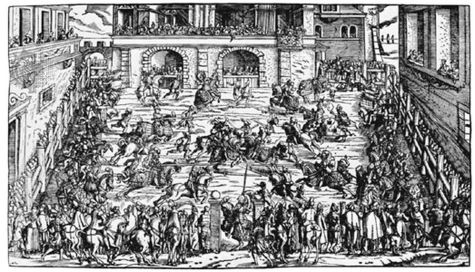

What Was Feudalism?
Before the period known as the Middle Ages, the Roman Empire controlled most of Western Europe. Under Roman rule, Europe was organized and unified region. But in 400 A.D., the Roman Empire was split in two: the western half and the eastern half. Over time, the east thrived, while the west declined. Various Germanic tribes began to move into the countries of Western Europe; they lived under their own laws and under the rule of their own chiefs or kings. Without a central government, life for the people of the West changed greatly.

At the start of the middle ages, Europe was divided into small areas ruled by local lords and each of the lords made their own set of laws to follow; this often led to much conflict and disorder. During this time, the most successful ruler was a Frankish king named Charlemagne, whose empire included much of western and central Europe. Charlemagne maintained order throughout his realm and kept watch on the nobles and landlords, who were in the habit of doing as they wished.

Charlemagne sent special agents into every district to see if the nobles followed his orders. He also rewarded the nobles for their military support. In exchange for providing knights, he gave nobles grants of land. This practice laid the foundation of feudalism, a system of government in which land was exchanged for military service by knights.
The rise of feudalism in Medieval Europe greatly affected the social structure, specifically the rights and responsibilities of those who were in the noble and peasant class. This rigid social structure, in turn, considerably impacted the society in different ways, ranging from the daily life of the people to the overall economy.

Feudalism is the most distinctive and significant factor of the early and central middle ages. Feudalism was the social, economic and political structure of Western Europe during this time. In the early middle ages, feudalism permeated every aspect of society and economics, determining everything from relationships between kings and lords, to how farmers grew and made use of their crops. Because Europe’s economy was agriculturally based, feudalism formed a social stratification that separated the different classes, yet, at the same time, bound them together with ties of loyalty, obligation and service.
The person of the higher social standing would offer protection and patronage. In exchange, the person on the lower level offered loyalty and promised to deliver their profits, such as crops or a portion of money earned.

During the early Middle Ages, feudalism was most prominent among rural areas of Europe, mainly in present day France, Germany, and England. The main force behind feudalism was economics. The more urban areas, such as Italy, Spain and Southern France, never fully adopted the system. Because Europe was so rural at that time, economics became synonymous with agriculture. Feudalism was directly related to land: how it was used and who received the benefits from it.
“In a period when wars and famine were incessant, service, in exchange for protection, became the keynote of society”
Historian Marjorie Rowling

In the feudal system, most of the rights and privileges were given to the Upper classes. In the hierarchical structure, the kings were at the topmost position, followed by nobles, knights and vassals or peasants.
A crucial aspect of these arrangements was loyalties. A member of a given class swore loyalty to the person above him, making a solemn promise called an oath of fealty. This connection proceeded up and down the entire feudal hierarchy.
Feudalism was a complex arrangement that defined the relationships of the different levels of the social hierarchy. These relationships were based on personal ties; for instance, a lord might guarantee a peasant a place on his land because their family may have worked there for generations.
The King

During the Middle Ages, the economy was primarily based upon by agriculture. In an agricultural society, land was equivalent to wealth: the more land you had in your possession, the richer you were. Economist Kenneth Jupp comments that during the early Middle Ages “land paid virtually all costs of government… throughout most of Europe”. So, the person who had control of the land was very important. Before feudalism, the Romans believed in private ownership of land.
Meanwhile, various Barbarian tribes typically shared it communally. Under feudalism, however, the king or the monarch owned all of the land in the country. The kings held this land by what they believed was “divine right”, the right to rule granted by God and then passed on through heredity. The king ruled the whole kingdom and was in charge of all the land, but it was physically impossible for the king to control every part of his massive kingdom by himself.

For instance, when William I, also know as William the Conqueror, won the Battle of Hastings, he could not control all of England by himself. After William I won the battle, he was also still the Duke of Normandy, so he had to travel to France weeks at a time to stay in power. Therefore, he needed a way to remain in control of England and keep his people loyal. He first built a castle—the Tower of London—to dominate the city. There, he kept soldiers to keep the people of England in check. He still, however, needed an actual way of governing the country. This is where feudalism comes into play. William divided the country in to plots of land. These parcels of land were ‘given’ to noblemen who were willing to die in battle for William. They in turn had to swear loyalty to William.

The portions of the land awarded to nobles by the king, typically given for service in battle or in other ways, were called fiefs. Fiefs varied in size. Some were single estates just large enough to support one knight and his family. Others were very large, consisting of whole countries or provinces. The king also granted land to the less powerful military men, the knights, who were called vassals.

The king had complete ownership and power in his kingdom, so he could do as he pleased. This meant that sometimes the land could be given to a noble who swore his loyalty to the king. Sometimes, however, it meant keeping the land in the family and passing it on to his successors, similar to how Charlemagne divided his land. From Charlemagne’s Divisio Regnorum, the king’s official proclamation of how he planned to divide the land among his three sons:
“So as not to leave my sons a confused and unsettled matter of dispute and contention as regards the status of my entire kingdom, I have divided the whole body of the realm into three portions; the portion that each of them is to guard and rule, I have caused to be described and designated. I have done this so that each may be content with his portion in accord with my ruling. And so that each may strive to defend the borders of his kingdom which face foreign peoples and maintain peace and charity with his brothers.”
The Nobles

In terms of the feudal system social hierarchy, the nobles or barons were the second wealthiest and the most powerful after the king in the chain. The nobles were awarded or leased land, called fiefs or fiefdoms, from the king whom they swore their loyalty to. Those who received the fiefs were called the king’s vassals. The king was the vassal’s lord. The vassals served him by providing him with armies and knights for protection. The lords owed homage and fealty to the king. They were obligated to supply a certain number of knights for the king. The number of knights a vassal owed his king usually depended on the size of the fief. The holder of a great fief might owe the king the service of dozens or even hundreds of knights. This level of vassalage was called lords, nobles, tenants-in-chief, or barons.

Within their own fiefdoms, lords were the absolute authority. They established and administered their own legal systems, gathered taxes, designed their own currency and managed how crops were grown. The rights of the fief and the titles of the land were passed down from generation to the next, usually to the male line. If a lord had no successor, the land would be given to the church as a sign of piety. The nobles were very powerful because they controlled the armies. In fact, nobles often warred amongst themselves over territories.

The governance of a fief was quite time consuming. For a lord to do any of the framework himself was considered to be beneath his level—he was considered more of manager. His wife was also like a “manager” of the manor. She was expected to make sure the daily operations, such as managing the servants and handling the financial accounts, ran smoothly. Despite these responsibilities of the lord’s wife, women during this time had few rights and were expected to follow their husbands and fathers on all things.

The daily life of a lord consisted of attending meetings in relation to his land. The lord was expected to exercise his judicial powers over the people of the land; they would hear reports on crops, harvests, supplies, and finances, such as taxes and rent. The lord would handle disputes among tenants. Whether a subject could marry or whom they could marry was also decided by the lord. Unlike the workers under them, lords had the leisure to revel in numerous activities. As the Medieval period progressed, the culture changed becoming more refined and elegant. Time was spent on the arts like poetry and music.

Sometimes, even the fiefs granted by the king were too large to govern by the lords. The lords, or barons, had to further divide up their land and these were ‘given’ to trusted knights who had also fought well in battle. He was given a piece of land to govern and he had to swear an oath to the baron, similar to how the baron swore an oath to the king, collect taxes when told to do so and provide soldiers from his land when they were needed. It is argued that sworn oath is really to the king and not the baron.
The Knights

Under the lords in the social hierarchy in the feudal system, came the knights. Knights were professional armored cavalry warriors, some of whom were vassals occupying land form the lords whose armies they served.
Since fealty and homage were key elements of feudalism, the fief was granted to a knight after a commendation ceremony that was designed to create a lasting bond between a vassal and his lord. The knight would swear allegiance to his lord—the Oath of Fealty. The Oath of Fealty was the promise of faithful service to the lord. To take an oath was a very reverential proceeding; it was an appeal to God, by which a man called down on himself divine punishment if he swore falsely.

A knight who had been rewarded with land pledged his military services. Whenever a war erupted, the knights were required to fight to protect the Lord, land and the people. The knights and their armies were required to fight a limited period of 40 days. The lords and knights were required to provide trained soldiers to fight for the king as well as their weaponry, armor and clothing.

At first, most knights were of humble origins, most of them not even possessing land, but by the later twelfth century knights were considered members of the nobility and followed a system of courteous knightly behavior called chivalry. The feudal structure made it possible for members of one social standing to move up to next level and this is what many aspired to do. Squires and Pages of the Middle Ages yearned to become knights. A Knight who proved valiant in battle could become wealthy. The most wealthy and powerful knights then joined the nobility.

Not everyone could become a knight. Firstly, knights usually came from a wealthy or noble family. The boys who would train to become knights were usually the sons of knights or lords. At the early age of 7 years old, the boy is sent the house of another knight or lord and there they are bestowed the title “page”. During this time, they were taught proper manners, and religion, as well as how to read, write and speak French and Latin. Pages acquired their first skills of knighthood by imitating knights and practicing combat with each other using wooden swords and lances.

At the age of 14, a page became a squire. The squire was an apprentice to the knight who handled the knight’s armor, served his meal, tended his horse and cleaned his weapons. Besides carrying out their duties in the lord’s household, squires learned the martial arts of being a knight. Squires also practiced wearing heavy armor to get used to the weight and using weapons. The Squire served in this role for seven years and became a Knight at the age of twenty-one.
The Knights, like the lords, also had some leisure time. A common pastime of knights was hunting with a bow and arrow. This expedition could take days and a hunting group usually consisted of many people including friends, household members, and visitors, plus a large number of servants. Tournaments were also popular outdoor pastimes. Sometimes a knight could even make a living form it. The tournaments were an essential part of feudalism as they acted as a necessary training ground for the knights.

Of the land awarded to the knight, a portion would be kept for the knight himself and the rest would be distributed the peasants and serfs. The lands granted to knights in England were called manors and the knight would live in a Manor House on his fief. Their main role was to give protection to the king and therefore they were paid quite well. The knight could also gain money, even fame, from tournaments. Therefore, the most successful of the knights were able to increase their lands and acquire more soldiers whom they might grant land to in turn for a sworn oath of loyalty.
The Peasants

At the bottom of the feudal system social hierarchy are the peasants and the serfs. They were the poorest and had an extremely hard and difficult lifestyle. Most of the people on a feudal manor were peasants who spent their entire lives as farmers working in the fields. The responsibility of peasants was to farm the land and provide food supplies to the whole kingdom. In return of land they were either required to serve the knight or pay rent for the land. They had no rights and they were also not allowed to marry without the permission of their Lords.

The peasants on a manor had several fields for their own use, sometimes by being tenant farmers—an arrangement in which they leased land from their lords. They usually worked together in these fields, particularly on jobs such as plowing. The peasants divided the land in narrow strips for each family. This way, everyone got a share of the good land and the poor land. A fief typically needed dozens of peasant families to maintain it, grow crops, and raise livestock. The life of a peasant was filled with arduous, monotonous work: planting and harvesting, raising and slaughtering live stock. Considering the amount of profits a fief produced, the peasants found it hard to get by.

Peasants had hard lives and not many privileges, but they were still not the lowest class. Below the peasants were menial workers called serfs. Although a serf had some freedoms, they were close to being slaves. Many of the peasants were serfs—that is, they were not free. Serfs belonged to the estates and in which they were born and were totally dependent upon their lords. Lords did not simply give away their serfs; if a serf was to marry a serf from another manor, the lord usually demanded payment for his loss.
The position of a serfs and peasants were made clear when Jean Froissart, a French medieval writer, wrote:
“It is the custom in England, as with other countries, for the nobility to have great power over the common people, who are serfs. This means that they are bound by law and custom to plough the field of their masters, harvest the corn, gather it into barns, and thresh and winnow the grain; they must also mow and carry home the hay, cut and collect wood, and perform all manner of tasks of this kind.”

The serfs worked a few days a week on the lord’s fields. They also did various chores for the lord, such as cutting firewood, fixing the castle’s walls, and cleaning the moat. The serf was also required to give payments, on top of the payments of crops the lord already receives at harvest time, at special times of the year—Christmas, Easter, ECT. Being a peasant or a serf was typically hereditary. When a serf died, his son had to make a payment to the lord of the manor.
Serfs led extremely difficult lives. They barely had access to or knew about the outside world, and they rarely met anyone from outside of their village. They couldn’couldn’t travel or read and write.
Conclusion
Feudalism was the government, social, and political structure of Medieval Europe and it greatly affected society, ranging from how a country was run, to the rights and responsibilities of the people, all the way down to the intricacies of a family. One of the main characteristics of feudalism was its social hierarchy. At the top of the social ladder was the King who ruled all of the land in the kingdom. Since it was impossible for a king to maintain in control of all of his subjects, he gave, or awarded, pieces of his land called fiefs to noble whom he trusted. The nobles were loyal to the king, but in their fiefdom, they were in control. From there, the Nobles, also known as Lords of the Manor, could further divvy up the land to Knights who offered military protection in exchange for land. The Knight was loyal to the Lord, who was loyal to the king. They would protect the land and the lord from outside invasions, and they could also be summed into battle at anytime by their Lords. Below the knights were the peasants.
The peasants, who were in charge of farming and raising live stock, leased land from the lord or the knights. At the bottom of the social hierarchy were the serfs who were practically slaves. They did, however, have a few more rights than slaves, but they were bound to the lord and the land they served for life. These loyalties and relationships of the feudal system social hierarchy deal with the rights and responsibilities of the people of medieval Europe.
Originally published by Weebly, republished with permission for educational, non-commercial purposes.






